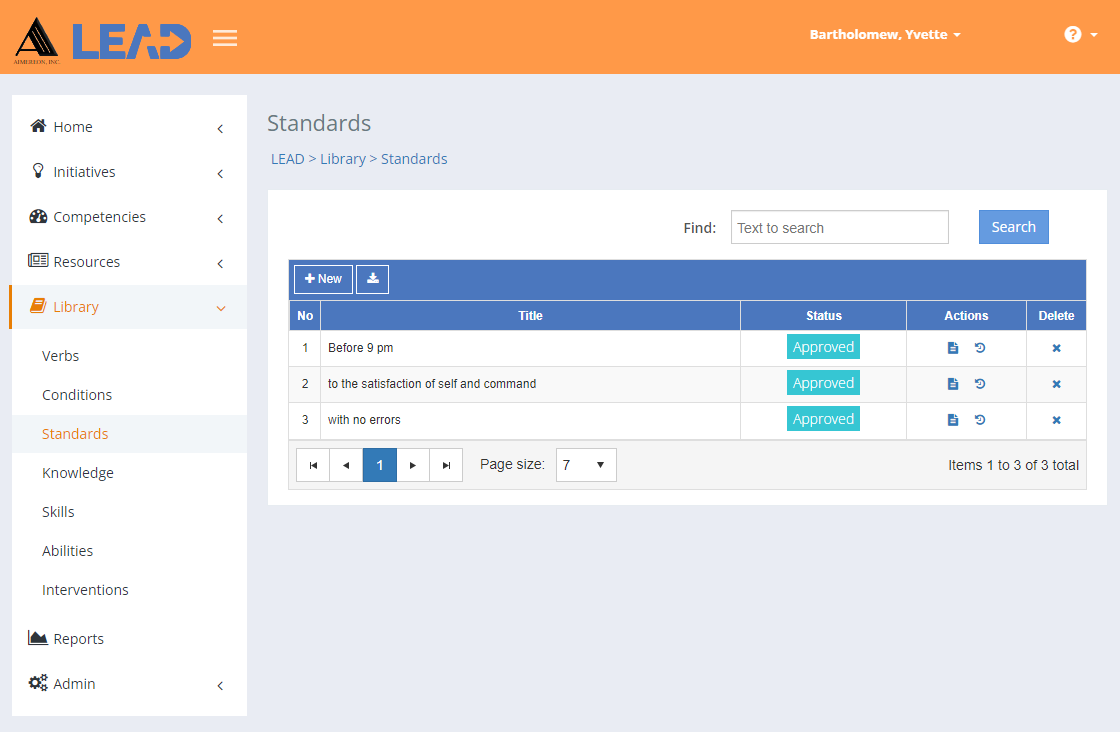What can you do on this screen?
On the Standards screen, you can create and manage the standards that are used for the tasks, subtasks, and steps in the task analysis in LEAD.

Figure 351: Standards
On the Standards screen, you can:
•Add a ![]() standard to the existing list by clicking on + New.
standard to the existing list by clicking on + New.
•Preview  the All Standards spreadsheet listing all standards in LEAD.
the All Standards spreadsheet listing all standards in LEAD.
•Select a standard and then:
oPreview  the:
the:
▪All Standards spreadsheet listing all standards in LEAD.
▪Related Materials Report that lists every initiative and place within each initiative where the selected standard is cited or used.
oReplace  one standard with another standard.
one standard with another standard.
Note: This will replace the standard everywhere it is used, including in approved initiatives! Hence, you will only see Replace  , when you have the Replace privilege as part of your role.
, when you have the Replace privilege as part of your role.
oView  the standard information.
the standard information.
oView  the standard and then select Approve the standard.
the standard and then select Approve the standard.
Note: Standards are automatically approved when the initiative that cites/uses the standards is approved.
oEdit  the standard information, as long as it has not been approved.
the standard information, as long as it has not been approved.
oSelect Show History  to review the changes made to the standard, including the user name and date/time of saved changes, and revert to an earlier saved revision.
to review the changes made to the standard, including the user name and date/time of saved changes, and revert to an earlier saved revision.
oDelete  the standard, if has not been cited in the task analysis of any initiative. Once you've selected OK to the confirmation message, an Undo button displays on the bottom left of the screen that allows you to revert the deletion.
the standard, if has not been cited in the task analysis of any initiative. Once you've selected OK to the confirmation message, an Undo button displays on the bottom left of the screen that allows you to revert the deletion.
Finding Standards
If you can't find the standard you're looking for, enter a search term in the Find: field and select Search. The table will list all standards that contain your search term on the screen. Select  to clear the search term and view all items again.
to clear the search term and view all items again.
You can click on the column headers of each table to sort the standards by that column. Clicking on a column header again will reverse the sort. Clicking on the column header a third time will remove the sort. Small arrows in the column header let you know which way the data is currently sorted.
Details on the Library > Standards Table
No
The number (No) column provides a sequential count of the entries, which is not attached to the entries themselves.
Title
The Title or text of the standard. Standards are used in the task analysis for tasks, subtasks, and steps to state how well the skill must be performed when it is performed. Standards describe the minimal acceptable level of performance to include accuracy, speed, quantity, and quality. Standards should be objective, observable, measurable, and should relate to the skill. The standard defines an acceptable product, an acceptable process, or both.
The standard should be defined as a product if the product is observable and can be inspected; the process by which the product was created cannot be easily observed; and the process is unimportant compared to the product. Product-based standards generally describe the product in terms of quantity (how many products are created in what period of time), accuracy, tolerances, completeness, format, number of errors, and/or clarity.
The standard should be defined as a process, if the performance of the skills does not result in an observable product; and failure to use the correct process could result in damage to equipment or endanger personnel. Process-based standards generally describe the process in terms of sequence, completeness, accuracy, and speed of performance.
When a standard combines both product and process, both the end result (the product) and how it was created are important. For example, delivering mail to a residence is a product standard, but if the delivery person destroys every other mailbox during the delivery process, the product standard alone would not be enough. Instead a standard for delivering mail could be: 'to every residence receiving mail without incident'.
Status
The current Status of the library item. Once the initiative that uses the library item is approved, then the library item is also approved. You can also approve a library item manually by viewing the item and then selecting Approve on the screen. You cannot approve a library item from the Edit screen.